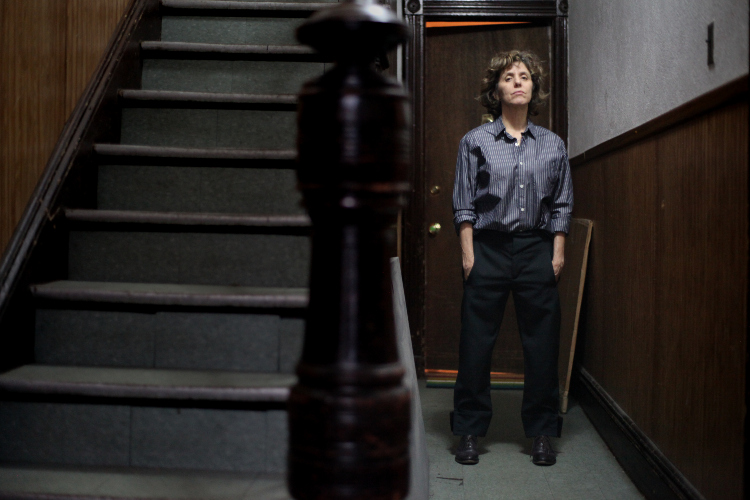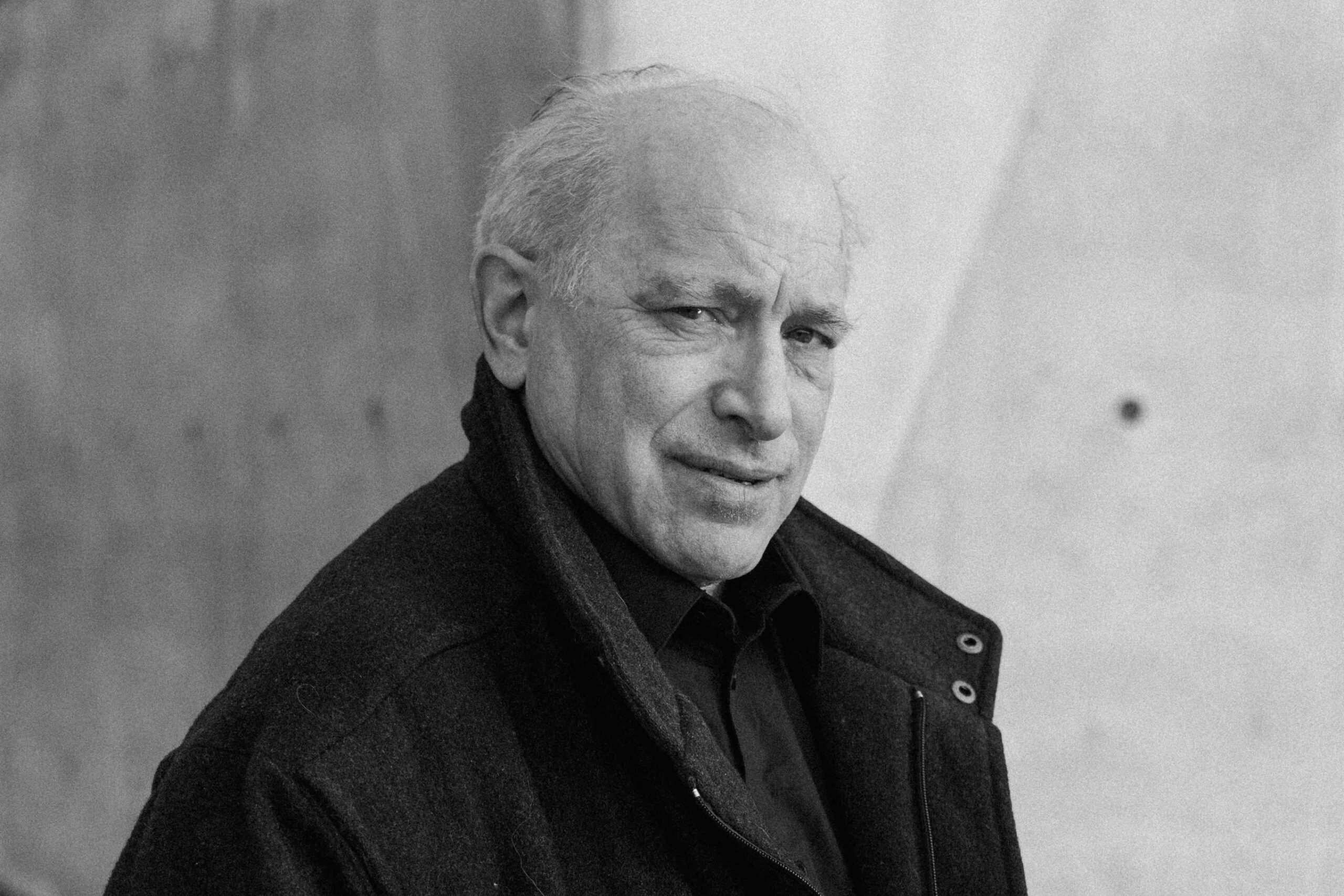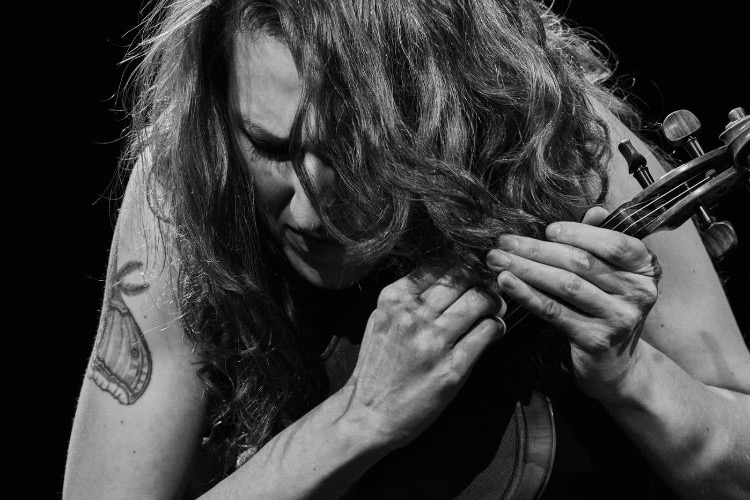Laced With Creativity: A Conversation with Zeena Parkins
|
Getting your Trinity Audio player ready...
|
When one thinks of lace as a fabric, often their immediate thought is delicacy and fragility. But appearances can be deceiving. Intricate lace patterns also reflect strength in their repetitive, yet morphing, shapes and the intense determination of those who craft them. Zeena Parkins’ LACE (Chaikin, 2023), the culmination of a decade and a half of composing through interpreting the thread paths of its namesake, exposes these other facets of the material for all to see.
Parkins excels at taking the perceptively gentle and exploring its sharpest edges. Through the use of field recordings, Foley, samplers, analog synthesizers, oscillators, and homemade instruments, she has discovered ways to take the stereotypically angelic tones of her harp into new realms. She has been a pioneer on the electric harp in particular. Parkins’ experimental zeal has led to collaborations with many other artists at the cutting edge of musical creation, including Björk, John Zorn, Ikue Mori, Fred Frith, Pauline Oliveros, Anthony Braxton, and Butch Morris. While Parkins’ LACE project has taken many forms over the years, including those featuring her instrument, she steps away from her strings for the recorded version.
The first movement finds Parkins conducting James Fei, Maggie Parkins, and the TILT Brass Sextet (Chris McIntyre, Jen Baker, Will Lang, Gareth Flowers, Sam Jones, and Tim Leopold) as they provide their far-gaze response to a particular stitch’s repetition of patterns. In the second movement, William Winant performs based on twenty-three action cards presented to him, each with a separate piece of lace. Both are compelling listening experiences. Despite the abstraction of patterns, surprisingly coherent melodies and themes emerge which make you reconsider the physical material surrounding us daily. Even more, both reflect Parkin’s unique voice, even as she does not play a single note.
We sat down with Parkins to discuss her experiences with lace, this recording, and the other movements of her expansive project.
PostGenre: You may be the first artist to use lace to compose.
Zeena Parkins: I’m sure someone has somewhere. I never think there’s only one person in the world doing something. But I will say that Lace has been a long-term project. Each time I create a new movement- or l what I’m calling a movement; using material differently to instigate different kinds of information – I always think it is the last time I will use lace to compose. But I always get intrigued by some new aspect I must figure out before I’m truly done. Lace, as a project, has generated many ideas for composing.
PG: You have been working with lace for many years now.
ZP: Yeah, this project started in 2008 as a commission from the Merce Cunningham Dance Company studio. Four composers – myself, George Lewis, John King, and Beth Ford – were invited to rehearse for a day or two and then have a concert. Each of us wrote a piece for the group, so there would be four pieces in the concert.
That process required us to each offer a piece that wouldn’t be so difficult that the musicians couldn’t learn it in a couple of hours. The piece needed to be built around improvisation since all four of us are improvisers. Many of the things I had been writing up to that time were more through-composed pieces. Those older pieces were incredibly difficult, and it seemed the performing musicians rarely had enough time to learn them. For the Merce Cunningham commission, I was confronted with the problem of how to generate music that felt like it had compositional integrity but wouldn’t be impossible to learn in this short amount of time.
PG: Why did you use lace to meet that objective?
ZP: Honestly, I had no interest in lace. I hadn’t collected lace. I wasn’t even attracted to lace. Ironically, lace ended up being such a useful compositional tool.
PG: But you were already interested in fabric, more generally, to some degree.
ZP: I was very much interested in textiles. When I first moved to New York in the ’80s, I lived with a costume designer, Liz Prince. We set up a sewing machine in the living room, and she sewed all the time. I also learned to sew and even made some of my own clothes.
At the time, we were living in the Lower East Side. The area was in the middle of gentrification, but there were still many little fabric stores stuffed to the brim with all kinds of fabrics. There were also many notion stores in the neighborhood where you could buy buttons, fasteners, trimmings, and zippers. I loved going into stores, buying fabrics, and making stuff. I did like textiles a lot, but not lace, in particular.
PG: Since you were initially averse to lace, how did the idea of using it to compose come to you?
ZP: I’m not sure how the idea came to me. But it was probably because of all the fabric lying around the house in front of me. I must have had some lace lying around because I used it in that first piece. I have always used lace that uses patterns that are very abstract and geometric rather than botanical. The ones I use always have patterns of circles, squares, triangles, or loops rather than flowers and plants. I am always interested in the abstract.
With the first movement, I arranged five pieces of lace and placed them on a black card. I made conditions for the players to apply to each piece. Those five pieces of lace made up the composition. The first time performing the movement was a test. It was a gamble that maybe the process would generate something interesting. And sure enough, it did.
It was as much of a gamble as when I made my electric harp with [cellist] Tom Cora. We made our first one out of some parts we found at a secondhand music shop. The first electric harp was a primitive version, but it showed us that the idea worked.
PG: When you started playing the electric harp, did you need to adjust in some way from playing a conventional harp?
ZP: It was an adjustment because there were no electric harps then, and I had to make one. Then the electric harp had to be refined. It also took time to learn how to hear my sound coming out of a speaker rather than the instrument itself. There’s no sounding body on an electric instrument. So, when I do something on the instrument, my sound comes out of a speaker away from me. That took me a while to get used to, solely because it’s not physically part of the instrument. But these are all things you learn over time, and you get used to as time passes.
In that sense, getting used to the electric harp is no different than when I started using lace to compose. Early on, I could see that the idea worked. But continuing to work with it is what made the idea practical. The way the lace material was presented – the fact that these five pieces of lace were each different in density – provided significant information. I then gave the players room to apprehend what the piece of lace was “saying” based on certain conditions I had set, and together the performers came up with a way to get through the five pieces.
PG: How did you come up with the conditions?
ZP: Well, I had realized from the start that the project was about patterning and the use of seemingly exact repetitions that morph into a pattern. I was very interested in how these patterns could morph and crossfade from one to another. Through the relational position of the shapes on different pieces, the performers understood which part was more sparse and which was more dense.
For one of the pieces of lace, instead of looking at the pattern, I told the performers, “OK, for this one, your point of view is going to be from the thread’s point of view.” I gave enough information that an improviser could hold on to and make something with. The idea of reading the texture and the patterns was essential.
PG: You stated in another interview that much of your sound is connected to touch. Do you feel that the physical feel of the lace plays into the compositions, or are they based solely on the visual representation of the lace?
ZP: Well, on that first version, I gave the performers the pieces of lace to look at on a board. It was before I realized that it might be a better idea to scan or Xerox the lace pieces. But I think, ultimately, you can’t separate the physical texture from how you read the material. Even when working with images of the lace, how you would expect it to feel is part of your interpretation. Even if not physically touching it, there’s that haptic connection.
PG: Do you feel that relying on something seemingly more abstract, like shapes and patterns, than a more established compositional language produces music that varies more from performance to performance?
ZP: Well, that’s a funny thing. There is no predetermined instrumentation for the compositions. Different orchestrations will obviously change how it sounds. But that said, especially in the first movement, the complexities or amount of information is so clear from piece to piece that it provides certain signposts for each performance. Those signposts seem to generate a kind of musical identity, and I found that so fascinating. You can tell by listening to the music whether it reflects a particular piece of lace. That is partly because of how the shapes in the lace relate to one another. The relationship of the material is going to be the same, even if different musicians using different instruments are approaching it.
For instance, it’s not about the pitches you’re playing. So you might not hear the same set of pitches used. Most likely you’re not. Except in the last composition of the first movement, where I give a couple of pitch sets. Otherwise, that kind of information is different every time, for sure. But there are things besides pitch that become identifiers for what marks the composition.
PG: Since you have worked on the first movement for many years with different instrumentation, why did you feel this particular version was the best one to record?
ZP: The one on the album was recorded from a live show at the Stone in 2019. Jeremiah Cymerman recorded it and did a beautiful job of these live recordings. That version was the first time I ever conducted the first movement of Lace. It was a light touch conduction but somehow, the whole piece kind of snapped together. You could say that’s like an extra layer of information added to the performance by having me conduct. And I am very happy with the results.
PG: How did the second movement come together?
ZP: For the second movement, I started manipulating pieces of lace. I started going out, finding, and collecting lace. When I was on tour, I would go to fabric shops and find things. But I was not content to just stick the lace on a board again. The materials were manipulated and it provides different kinds of information for the performers. These action cards offer another way to think about compositional strategies.
PG: And the third movement?
ZP: The third movement is based on the lace knitted in the Shetland Islands. They use gridded knitting patterns to make lace. We used those patterns as scores. I put a band together called Green Dome with Ryan Ross Smith and Ryan Sawyer. And we spent months doing a deep dive into pattern after pattern to collect very specific details about the lace: how many stitches, what kinds of stitches, how the shapes and proportions affected the form, and how to translate that information into sound. The group provided an opportunity to investigate how to make a score out of a lace pattern.
PG: As far as witnessing the laceatelier at work, do you feel your experiences making your own clothing and instruments gave you a greater appreciation of their work?
ZP: The experience of watching them was really interesting. My friend, the set designer, Nadia Lauro, and I were working on yet another movement of the Lace project called Stichomythia.This project researched the question of the motif and how it is perceived. It was a visual installation and a musical performance that included three movement artists. In this collaborative work Nadia made an anamorphic carpet that became at once my environment to perform in and my score, a space-score.
When creating Stichomythia, Nadia and I were invited to visit a laceatelier in Magalas, a little village near Montpellier, France. I had a romantic fantasy of what it would be like to go to a laceatelier. I thought the lace making was going to be located in some ancient castle or something.
PG: Presumably, it was made somewhere less grand.
ZP: Yes. We got there and found that they were making the lace in a kind of prefab cement building owned by the ladies’ auxiliary club or something. But the laceateliers were amazing. They were these completely self-sufficient ladies. They came in with everything they needed to do their project – a little stool and fold-up table, lace pillows, wooden bobbins, and threads.
Everyone sets up in a semicircle in this room with fluorescent lights. There is not a lot of talking because they have to deeply concentrate. You really can’t have a full-on conversation with someone when they are making lace.
One thing that struck me was how long their little lace projects would take to make. Making them is a slow process, and the amount of dedication and focus needed for these projects is mind-blowing. Most of the women making them had been doing so for years. They were fast in making it, but there was so much detail in their work that they often did not finish a project in a week, month, or even years. Their devotion is incredible.
PG: In a way, that devotion may parallel how you have continued to use lace as a compositional for many years. Looking forward, where do you see this project leading you?
ZP: I’m doing a second version of Stichomythia as a solo project. I’m currently working on patches for each piece of that project. I have been wanting to do a solo project using this information. So that’s where I’ve landed now. I’m going to take the solo project on the road. I’m already arranging for a bunch of solo concerts. I’m going to be performing it in December in Zurich, Switzerland. And I’ll be performing it again at Mills College.
PG: The school was formerly known as Mills College. [Ed. In 2022, Mills merged with Northeastern University. Parkins began teaching at Mills in 2011].
ZP: Formerly known as Mills, yeah.
PG: Now that your time teaching at Mills has ended, do you feel you will be performing more, or do you plan to start teaching somewhere else?
ZP: Well, that is the million-dollar question. It’s barely been four weeks since I left Oakland and went back to New York. I love to teach, but the right opportunity has not yet presented itself. I’ll just keep my antenna up until the right one does. I do want to play more because as the teaching got more and more important, I became less active performing though I continued to write a lot. But that will now change. I’m not sure where things are going to land yet, honestly. But I’m excited to see the next chapter.
LACE is now available on Chaikin Records. Deluxe box sets, vinyl, and digital versions can be purchased on Bandcamp. More information on Parkins can be found on her website.
Photo credit: Jeff Preiss




One thought on “Laced With Creativity: A Conversation with Zeena Parkins”